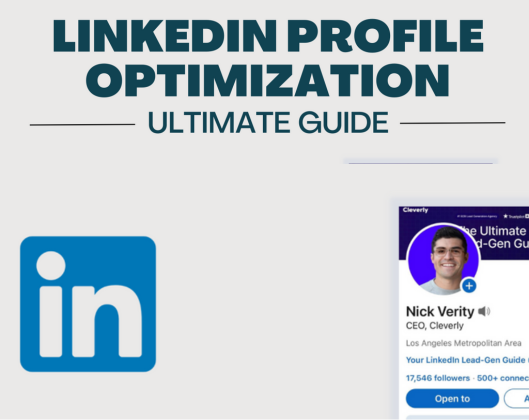Did you know that LinkedIn is used to hire eight job seekers every minute?
Considering that 95% of recruiters use LinkedIn to find their next hiring, you must make sure your profile is unique and makes an effective first impression. But the question is how to create a linkedin profile for a job?
To the professional networking site LinkedIn has grown to be an essential tool for job searchers. Having a profile that stands out is important because millions of recruiters and businesses use LinkedIn to locate possible prospects.
We'll walk you through the ten steps of creating a strong LinkedIn profile in this article.
To see if your profile is suited for your ideal position.
Let's discuss them in detail, but firstly discuss the significance of linkedin profile
What is The Significance Of Your LinkedIn Profile For a Job?
The most important digital resource for your job search is your LinkedIn profile.
"LinkedIn is the place to go for your next opportunity," says Jasmine Escalera, a career counselor. It is the ideal setting for showcasing your identity and areas of passion. It is the most effective way to connect with possible employers.
The following justifies the importance of having a strong LinkedIn profile:
- If a recruiter wants to assess your professional aptitude, they look at your LinkedIn page.
- You can be found on Google thanks to your LinkedIn profile.
- It is the ideal setting for developing your brand and establishing yourself as an authority in the field.
- LinkedIn gives you the opportunity to network with individuals worldwide in a variety of industries. Additionally, it provides you with access to hiring managers, recruiters, and potential employers.
- By the second quarter of 2023, there were over 63 million businesses using LinkedIn. This implies that LinkedIn members have simple access to job boards and a vast network of employment chances.
- LinkedIn provides a variety of courses to help you develop your skills and increase your employability. To get started, see our guide to LinkedIn certifications.
10 Easy Steps For a Successful Job Through Effective LinkedIn Profile:
Maintaining an impressive online presence is essential in today's competitive employment market. The professional networking site LinkedIn has grown to be a vital resource for job searchers. Having a distinctive LinkedIn profile is essential because millions of recruiters and businesses use it to locate possible candidates. A thorough guide on building a LinkedIn profile that is tailored for job search success is given in this article.
Step 1: Sign in your Account
.png)
Defining Your Intention
It's essential to specify your purpose when making a profile. Are you trying to build your professional network or are you actively looking for a new job? You can customize your profile and interactions on the platform by making your aims clear.
Creating an Account
- Go to LinkedIn.com
- Click "sign in" or "New to LinkedIn? Join now".
- Enter your email address or phone number and create a password.
- You can also sign up using your Google account.
- Answer the basic questions, such as your first and last name
Step 2: Optimizing Your Profile Picture and Background
(1).png)
Professional Profile Picture
Your profile picture is often the first thing recruiters notice. It should be a recent, professional image that meets the following criteria:
- You Alone: You should be the only person in the photo.
- Simple Background: Make use of a background that is unobtrusive and simple.
- Centered Face: The focal point of the picture should be your face.
- Good Quality: The image must be bright and clear.
- Dress appropriately for the position you're applying for.
- Smiles can help you come across as more approachable.
Background Image
Remember to include a background image. This is an additional chance to present your professional brand. Select a picture that reflects your interests or industry while also being visually appealing.
Step 3: Creating an Attention-Grabbing Headline
(2).png)
Why a Headline Is Important?
In no more than 220 characters, your LinkedIn headline serves as a succinct summary of who you are. Since it's one of the first things recruiters see, it should be interesting and descriptive.
Customizing Your Headline
Your most recent job title will appear as your headline by default. You should alter it, though, to emphasize your interests and areas of experience. When recruiters are searching for applicants, a well-written headline might help you show up in search results.
Example Headlines
- "Software Engineer | Full Stack Developer | Java, Python, JavaScript"
Important Features to Add
- Your Present Position: Give a brief description of your current position or specialty.
- Your Proficiency: Emphasize your primary abilities and credentials.
- Your Goals: Describe the kind of position you are looking for.
Step 4: Crafting an Engaging Summary
(3).png)
The Objective of a Summary
You have the chance to share your career story in your LinkedIn summary, sometimes referred to as the "About" section. You can use it to promote your brand and personalize your experience.
Essential Elements of a Successful Summary
- Give a brief introduction: Give a brief introduction of yourself in one or two sentences.
- Emphasize Your Experience: Give three to five sentences summarizing your background, strongest suit, and main interests.
- Include Keywords: To improve your exposure in LinkedIn searches, include keywords relevant to your sector.
- evaluate Your Accomplishments: Whenever feasible, use statistics and numbers to measure your achievements.
- Think about the position you’re looking for next.
- Determine one or two things that the organization or position requires of you in order for you to succeed there.
- Examine the job description and other sample job descriptions for the position or positions you are applying for.
- Take note of one or two very significant points that are included in the job descriptions. Make sure your LinkedIn headline focuses on it.
Example: Web Developer at ABC Company | Full Stack Engineer | Front End Specialist | HTML5, CSS3, Bootstrap, JQuery, PHP
Writing summary
Tips for Writing a Great Summary
- Write in the First Person: This makes your summary more personal and engaging.
- Use a Conversational Tone: Avoid jargon and write in a way that is easy to understand.
- Keep it Concise: Recruiters are busy, so keep your summary brief and to the point.
- Proofread Carefully: Ensure your summary is free of errors in grammar and spelling.
Step 5: Detailing Your Work Experience
(4).png)
Consider LinkedIn to Be Like a Resume
Like an ordinary resume, the work experience portion of your LinkedIn profile serves the same purpose. LinkedIn, however, gives you greater room to elaborate on each job.
Giving Thorough Descriptions
- For each position you've held, describe your employment responsibilities. Recruiters and hiring managers can use this to find you the ideal position.
- Including Keywords: Use search-engine-optimized keywords that are relevant to your work and your qualifications when outlining your duties. You will rank better in LinkedIn's search results if you do this.
- Quantifying Your Accomplishments: Whenever feasible, use statistics and numbers to quantify your accomplishments. This offers verifiable proof of your abilities and achievements.
Step 6: Listing Your Skills and Obtaining Endorsements
(5).png)
Skills Are Essential
Putting your best abilities on display is essential to getting recruiters' attention. When they search for candidates using appropriate keywords, it also makes it easier for them to locate you.
Listing Hard and Soft Skills
Display your versatility by combining both hard and soft talents. Technical aptitudes are known as hard skills, whilst communication and interpersonal skills are known as soft skills.
Obtaining Support
Request recommendations for your abilities from your contacts. Endorsements give your profile more legitimacy and show that people are aware of your skills.
Completing Skills Evaluations
If you want to prove your skills, think about taking LinkedIn's tests. By passing these tests, you can improve your exposure and profile.
Step 7: Completing the Education Section
(6).png)
Adding Your Education
Provide information about your degrees, certifications, and other academic accomplishments in the education area.
Highlighting Relevant Coursework
Emphasize pertinent education and projects to demonstrate your abilities and understanding if you have little professional experience.
Step 8: Showcasing Volunteer Experience
(7).png)
Demonstrating Your Values
Showcasing your volunteer experience demonstrates your values and commitment to giving back. It also provides an opportunity to highlight additional skills and experiences
Step 9: Customizing Your Profile URL
(8).png)
Creating a Custom URL
When you first create your LinkedIn profile, you get an automatically generated URL that includes a string of numbers. Customize your URL to make it more professional and easier to share
How to Customize Your URL
- Click the "Me" icon at the top of your LinkedIn homepage.
- Click "View Profile."
- On the right side of the page, click "Edit public profile & URL."
- Under "Edit your custom URL," click the "Edit" icon next to your public profile URL.
- Customize your URL.
Step 10: Staying Active and Engaging
Connecting with Others
Since LinkedIn is a social networking site, it's important to establish connections with other professionals in your field. Participate in conversations, join groups that are pertinent to you, and contribute your knowledge.
Content Sharing: Distribute blog entries, articles, and other pertinent content related to your sector. This helps you develop your personal brand and shows off your knowledge and experience.
Engaging with Posts
Like, comment on, and share posts from other users. This helps you build relationships and expand your network.
Setting Your Profile to "Open to Work"
LinkedIn allows you to discreetly set your profile status as "open to new opportunities". This lets recruiters know you're looking for a job when they find you in search results.
Strategies For Successful LinkedIn Profile
Take into account the following tactics when creating a successful LinkedIn profile
- Create an Outstanding Profile: Your LinkedIn profile is more than simply a CV; it is the foundation of your professional identity. It displays your accomplishments, knowledge, and distinct personality.
- A professional, high-quality profile picture and a backdrop photo that reflects your professional identity are essential.
- Strong Headline: Craft a captivating headline that highlights your work and your desired professional image. In a memorable tagline, it should succinctly showcase your area of expertise, special talents, or desired career path.
- Customized Synopsis (About Section): Describe your professional background, significant achievements, and your contributions. The opening lines of your profile should "hook" a visitor and convey your identity, interests, and goals.
- Relevant Keywords: Throughout your profile, particularly in the overview and experience sections, include pertinent keywords related to your career and industry.
- Display Experience and Skills: Emphasize your professional path with particular accomplishments and abilities that others have acknowledged and approved of.
- Complete Other Sections: Complete as many sections as you can, including those about languages, publishing, education, and organizations.
- Volunteer Experience: Include your community service and extracurricular activities to give your profile a more personal touch.
- Optimal Posts & Engagement: Post relevant information and interact with your contacts by leaving thoughtful comments on their posts and contributing insightful commentary. Distribute content that is pertinent to your business, position, and sector.
- Actively Expand Your Network: Participate in online and live networking events, join LinkedIn Groups, and establish connections with industry experts.
- Emphasize Your Services: Make sure your profile prominently displays any services you provide.
- Promote and Get Promoted: Promote coworkers and experts you've collaborated with, and invite others to do the same for you.
- Stay Active: Keep up an active LinkedIn profile by regularly sharing updates, articles, and insights that benefit your network.
- Make Use of LinkedIn's Advanced Tools: To meet the proper individuals and take advantage of new chances, make use of LinkedIn's built-in tools, such as Sales Navigator and its sophisticated search capabilities.
- Make Your Profile Public: To ensure that anyone can locate you on LinkedIn, make your profile public.
Conclusion
In conclusion, there are a number of important steps involved in developing a successful LinkedIn profile for job searching. If you want to be more visible in recruiter searches, you should fill out every box completely. To properly customize your LinkedIn profile and conversations, it's critical to have a clear goal for your activity. To highlight your abilities and experience, create an attention-grabbing headline and synopsis with keywords relevant to your sector. Give thorough accounts of your experiences, quantifying your accomplishments and using appropriate search terms.
To increase credibility, look for suggestions and certifications of your skills. Finding and sharing your profile is made simpler with a personalized URL. Lastly, continue to be active and interact with your network by interacting with other professionals, exchanging content, and taking part in debates. You may greatly improve your chances of being seen by recruiters and getting your ideal job by making sure your profile is optimized and interacting on the platform.








![What is The Expat Loans in Saudi Arabia:? [A Comprehensive Guide 2025]](https://humanonline.org//uploads/articles/image_1745306071.webp)